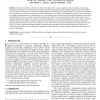Free Online Productivity Tools
i2Speak
i2Symbol
i2OCR
iTex2Img
iWeb2Print
iWeb2Shot
i2Type
iPdf2Split
iPdf2Merge
i2Bopomofo
i2Arabic
i2Style
i2Image
i2PDF
iLatex2Rtf
Sci2ools
TVCG
1998
1998
Dynamic Catmull-Clark Subdivision Surfaces
—Recursive subdivision schemes have been extensively used in computer graphics, computer-aided geometric design, and scientific visualization for modeling smooth surfaces of arbitrary topology. Recursive subdivision generates a visually pleasing smooth surface in the limit from an initial user-specified polygonal mesh through the repeated application of a fixed set of subdivision rules. In this paper, we present a new dynamic surface model based on the Catmull-Clark subdivision scheme, a popular technique for modeling complicated objects of arbitrary genus. Our new dynamic surface model inherits the attractive properties of the CatmullClark subdivision scheme, as well as those of the physics-based models. This new model provides a direct and intuitive means of manipulating geometric shapes, and an efficient hierarchical approach for recovering complex shapes from large range and volume data sets using very few degrees of freedom (control vertices). We provide an analytic formulation ...
| Added | 23 Dec 2010 |
| Updated | 23 Dec 2010 |
| Type | Journal |
| Year | 1998 |
| Where | TVCG |
| Authors | Hong Qin, Chhandomay Mandal, Baba C. Vemuri |
Comments (0)

